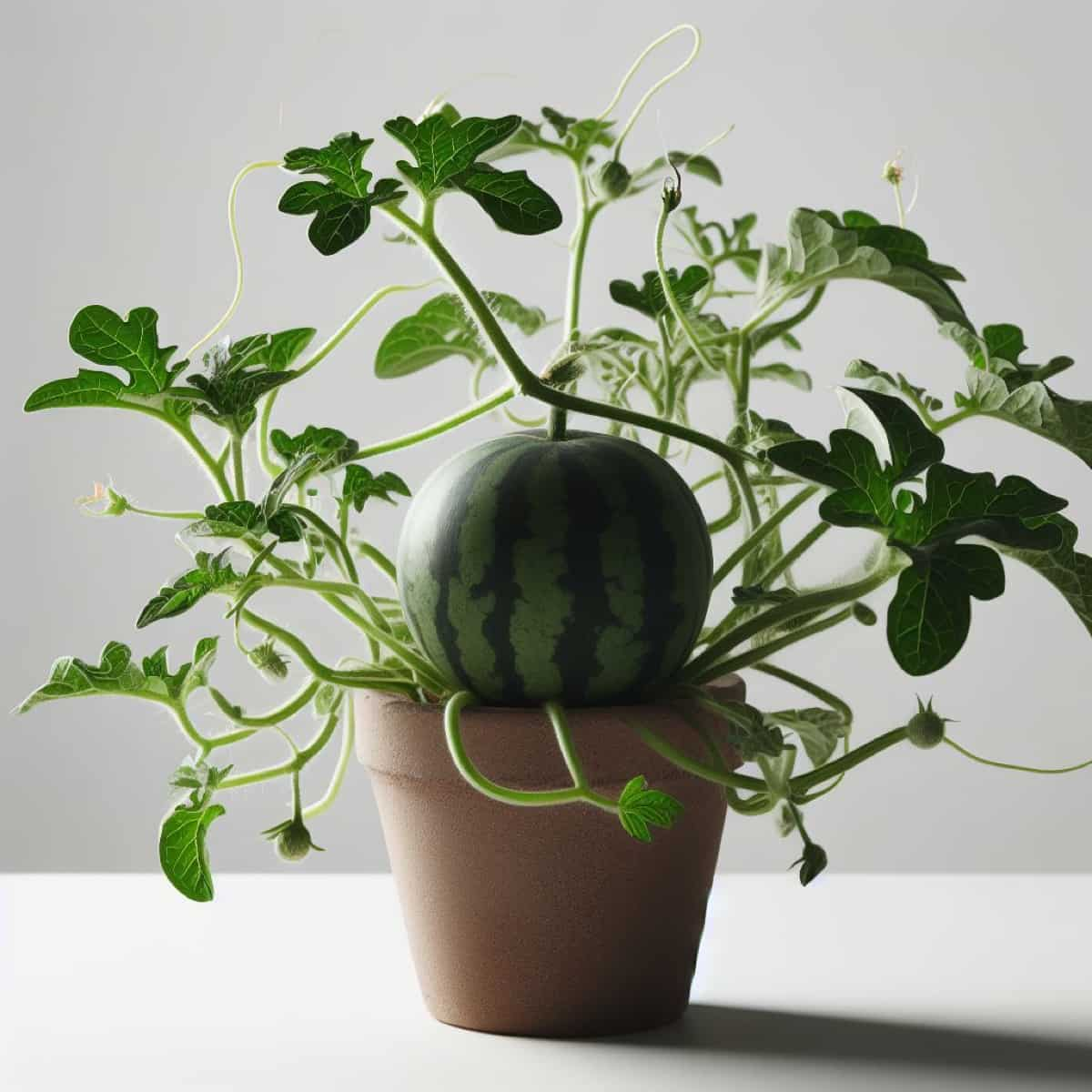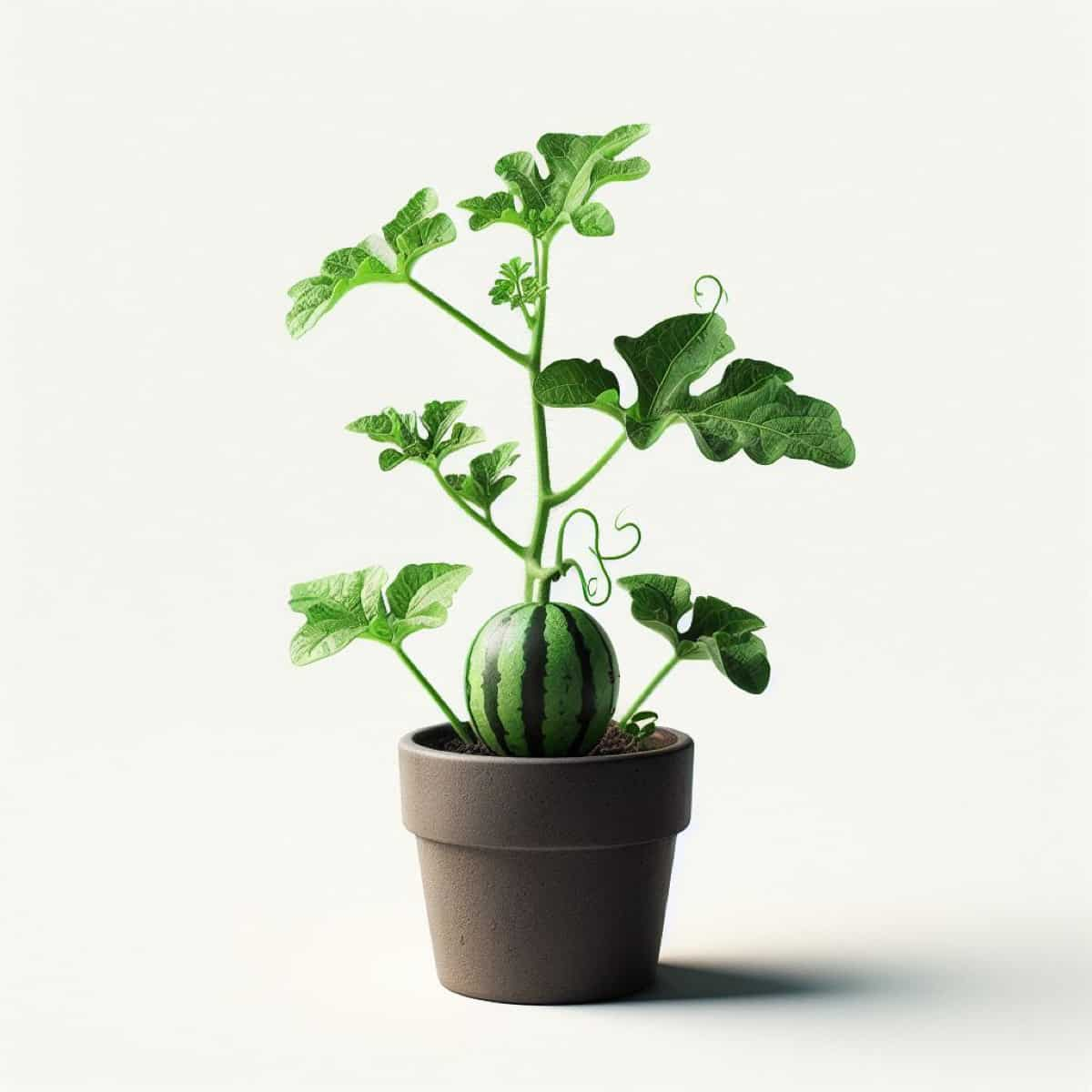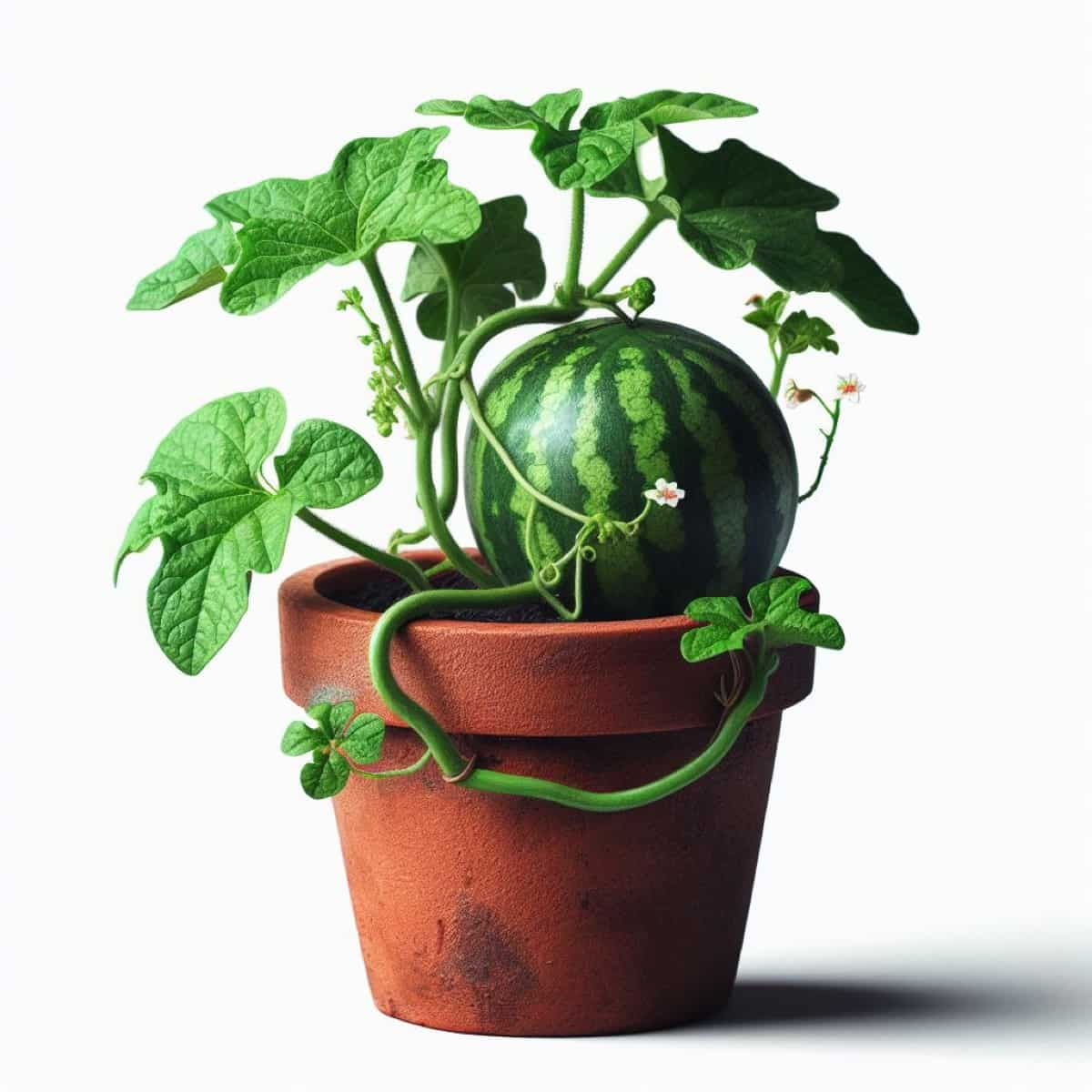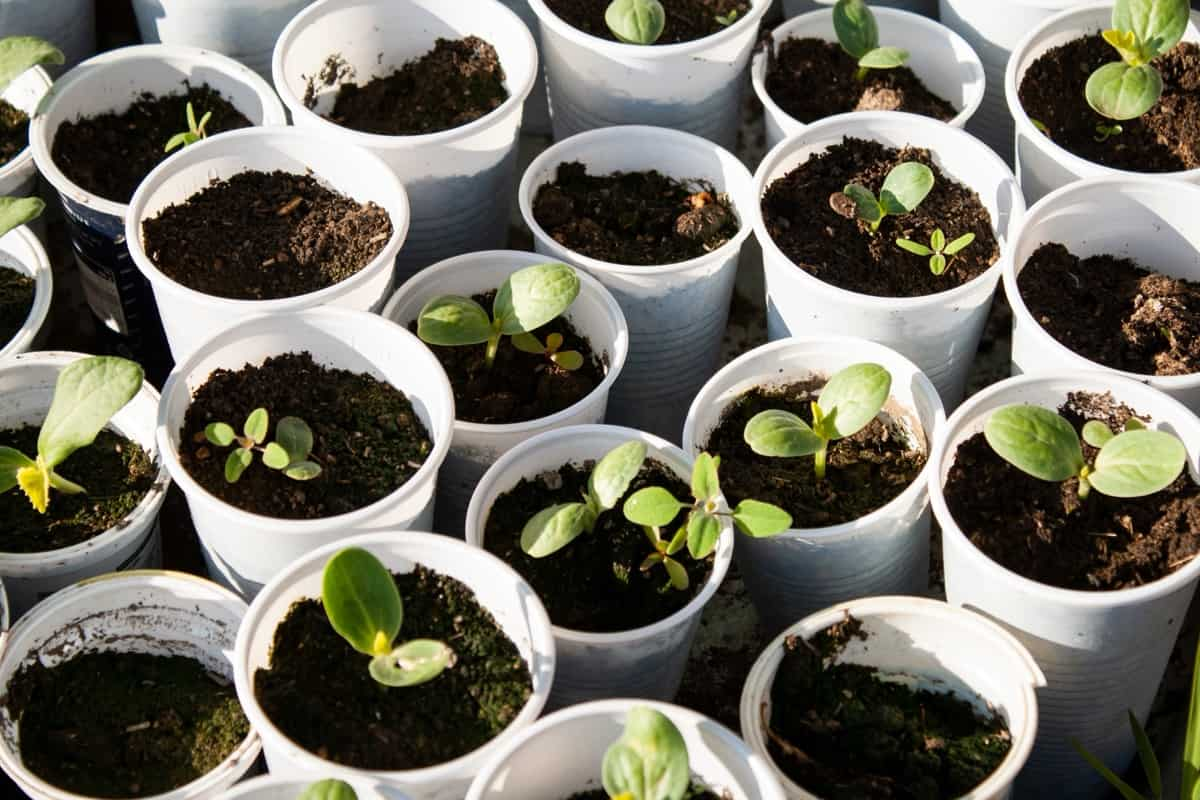Fertilizing potted watermelon vines is crucial for promoting healthy growth and a bountiful harvest. Using organic, natural, and homemade fertilizers ensures a chemical-free, eco-friendly approach. Optimal nutrition can be achieved by understanding the NPK ratio (Nitrogen, Phosphorus, Potassium) tailored to watermelon’s needs.

Applying fertilizer at the right time and in the proper manner is essential. This guide will detail organic and homemade fertilizer options, the ideal NPK ratio for watermelon and offer insights on when and how to apply these fertilizers to your potted watermelon vines, ensuring they thrive and yield delicious fruits.
Fertilizing Potted Watermelon Vines
Organic Fertilizers for Watermelon Vines in Pots: Nurturing Your Plants Naturally
For eco-conscious gardeners, organic fertilizers provide a sustainable approach to nurturing potted watermelon vines. Opt for compost, well-rotted manure, or organic granular fertilizers with balanced NPK ratios (e.g., 5-5-5). These options enhance soil health, promote beneficial microorganisms, and reduce chemical runoff. Apply them in early spring, incorporating them into the soil surface. Supplement liquid organic fertilizers like fish emulsion during the growing season for an extra boost. Organic fertilizers not only provide nutrients but also foster a healthier, more resilient plant, all while minimizing harm to the environment.
Natural Fertilizers for Watermelon Vines in Pots: for Environmentally-friendly Options
Choosing natural fertilizers for your potted watermelon vines aligns with environmentally friendly gardening practices. Utilize options like compost tea, seaweed extract, or worm castings, which are rich in micronutrients and enhance soil structure. These natural choices support watermelon vines’ nutrient uptake and overall vitality. Apply them in early spring and as foliar sprays during the growing season. These sustainable alternatives nourish your plants and minimize the ecological impact of gardening, making them a preferred choice for those concerned about environmental stewardship.
Homemade Fertilizers for Watermelon Vines in Pots: DIY Solutions for Optimal Plant Health
Crafting homemade fertilizers offers a cost-effective and customizable solution for optimal potted watermelon vine health. Consider creating compost-based fertilizers by mixing compost with water and letting it steep to create a nutrient-rich liquid. Alternatively, concoct a DIY banana peel or eggshell fertilizer to boost potassium and calcium levels. To maintain a balanced NPK ratio, blend kitchen scraps, coffee grounds, and crushed eggshells.
Apply these homemade fertilizers during the growing season, ensuring even distribution to avoid overfeeding. Homemade fertilizers provide essential nutrients, reduce waste, and promote self-sufficiency in gardening. Experiment with different recipes to find the best for your potted watermelon vines.
NPK Ratios and Their Importance in Selecting Fertilizers for Watermelon Vines in Pots
The NPK ratio, representing the Nitrogen (N), Phosphorus (P), and Potassium (K) content in fertilizers, plays a pivotal role in nurturing healthy watermelon vines in pots. Watermelons have specific nutrient requirements; understanding these ratios is essential for proper growth and fruit development. Nitrogen (N) encourages lush foliage and vine growth, which is crucial during the initial stages.
In case you missed it: Watermelon Growing Stages and Watermelon Growth Time Lapse

Phosphorus (P) supports root development and flowering, which is vital for the watermelon fruit set. Potassium (K) aids overall plant health and fruit quality, promoting disease resistance. A balanced NPK ratio like 5-10-10 or 10-10-10 for watermelon vines in pots is recommended. However, the precise ratio may vary based on soil nutrient levels, which should be assessed through soil testing.
Slow-release Fertilizers: Enhancing Nutrient Availability for Watermelon Vines in Pots
Slow-release fertilizers are an excellent choice for potted watermelon vines as they provide nutrients gradually over an extended period. These fertilizers enhance nutrient availability, ensuring a steady supply to the plants without the risk of over-fertilization or nutrient leaching. Slow-release granules or pellets are mixed into the potting mix before planting, creating a consistent nutrient source for the growing season.
This gradual nutrient release supports balanced growth, root development, and fruit production, reducing the need for frequent fertilization. Additionally, slow-release fertilizers reduce the risk of nutrient imbalances and can be particularly beneficial in maintaining stable pH levels in the soil, promoting optimal nutrient uptake by watermelon plants.
pH Levels and Fertilizer Selection for Watermelon Vines in Pots: For Balanced Soil Environment
Maintaining the right pH level in the soil is crucial for healthy watermelon vines in pots. Watermelons typically thrive in slightly acidic to neutral soil with a pH range between 6.0 and 6.8. The soil pH affects nutrient availability, and an imbalanced pH can lead to nutrient deficiencies even with proper fertilization. When selecting fertilizers for potted watermelon vines, it’s essential to consider their impact on soil pH.
Organic fertilizers, like compost and well-rotted manure, tend to be slightly acidic and can help lower pH if your soil is alkaline. Conversely, if your soil is too acidic, incorporating lime or wood ash as a calcium source can help raise the pH.
The Importance of Timing: When to Apply Fertilizer to Watermelon Vines in Pots
Timing is critical when applying fertilizer to watermelon vines in pots. Early in the growing season, focus on nitrogen-rich fertilizers to promote vigorous vine and leaf growth. This initial application should be done shortly after transplanting or when the seedlings are established. As the vines flower and set fruit, transition to a balanced fertilizer with a suitable NPK ratio to support fruit development.
Be cautious not to over-fertilize during this phase, as excess nitrogen can lead to more foliage growth at the expense of fruit production. Regularly monitor your plants’ progress and adjust your fertilization schedule accordingly. Avoid late-season fertilization to prevent excessive vine growth and encourage fruit ripening. Proper timing ensures nutrients are available when the plants need them most, maximizing your watermelon harvest.
How to Apply Fertilizer to Watermelon Vines in Pots: Techniques for Maximum Effectiveness
- Surface Application: Sprinkle granular or slow-release fertilizer evenly on the soil surface around the base of the plant. Avoid direct contact with the stem to prevent burning.
- Watering-in: After applying fertilizer, water the plants thoroughly. This helps nutrients penetrate the root zone and become accessible to the plant.
- Foliar Feeding: Occasionally, spray a diluted liquid fertilizer on the leaves. This can provide a quick nutrient boost but should not replace regular root fertilization.
- Timing: Apply fertilizer early in the growing season for vegetative growth and transition to fruiting-specific fertilizer as vines flower and set fruit. Avoid late-season fertilization to promote ripening.
- Read the Label: Always follow the dosage instructions on the fertilizer package and consider soil testing for precise nutrient management.
In case you missed it: Growing Black Diamond Watermelon from Seeds: Origin, History, Size, and Varieties

Water-soluble Fertilizers for Potted Watermelon Vines
Water-soluble fertilizers are a convenient choice for potted watermelon vines. These fertilizers come in powder or liquid form and readily dissolve in water, making providing a quick nutrient boost easy. Mix water-soluble fertilizers with water and apply them to the soil around your watermelon plants.
This method allows for rapid nutrient absorption, ensuring your potted watermelon vines receive the necessary elements for healthy growth. However, following the manufacturer’s instructions for proper dilution and application frequency is essential to avoid over-fertilization and maintain a balanced nutrient supply for your watermelon vines.
Table for Fertilizing Potted Lychee Trees: Organic, Natural, Homemade, NPK Ratio And When to Apply
| Type of Fertilizer | Fertilizer | When to Apply |
| Organic | Compost, Well-aged manure | Before Planting |
| Natural | Epsom salt, Compost Tea | As side dressing |
| Homemade | Banana Peels, Eggshells | As side dressing |
| NPK ratio | 5-10-10 or 10-10-10 | 3-4 splits per season |
| Water soluble | Blood meal, Fish Emulsion | During growing season |
| Slow release | As spikes available in the market | During growing season |
In case you missed it: Watermelon Companion Plants: Chart, Benefits of Growth and Yield

Conclusion
By choosing eco-friendly fertilization methods and understanding the plant’s evolving nutrient needs, you can promote healthy growth, robust fruit development, and a bountiful yield. Remember to adapt your fertilization strategy as your watermelon vines progress through different growth stages, ensuring they receive the essential nutrients they require for a successful and delicious harvest.
- Feed Your Flock for Less: Top 10 Tips to Save on Chicken Feed
- Ultimate Guide to Ossabaw Island Hog: Breeding, Raising, Diet, and Care
- Hatching Answers: The Top 10 Reasons Your Chickens Aren’t Laying Eggs
- Eggs and Economics: Breaking Down the Cost of Raising Backyard Chickens
- Defend Your Greens: Proven Methods to Keep Iguanas Out of Your Garden
- Ultimate Guide to Cinnamon Queen Chicken: A Comprehensive Guide for Beginners
- Ultimate Guide to California Tan Chicken: Breeding, Raising, Diet, Egg-Production and Care
- Ultimate Guide to Marsh Daisy Chicken: Breeding, Raising, Diet, and Care
- 10 Types of Chicken Farming Businesses You Can Start for Profits